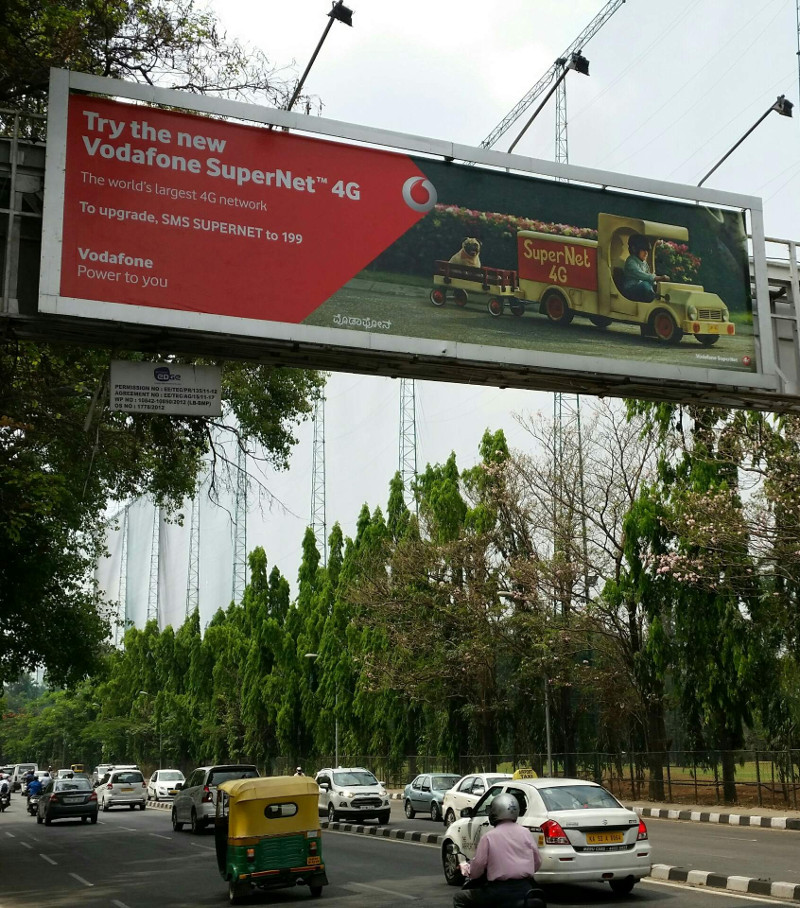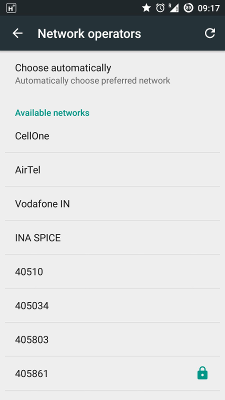 I’ve been in Bangalore for a week recently and was quite surprised about the huge number of networks shown when performing a manual network search. Over the weekend I had a closer look at the system parameters of some of the networks and was quite surprised that I didn’t quite find what I expected.
I’ve been in Bangalore for a week recently and was quite surprised about the huge number of networks shown when performing a manual network search. Over the weekend I had a closer look at the system parameters of some of the networks and was quite surprised that I didn’t quite find what I expected.
 The screenshot on the left shows a total of 8 networks! Before taking a closer look I thought that a lot of them must just be MVNOs (Mobile VIRTUAL Network Operators) sharing a single carrier frequency with other MVNOs and the physical network operator itself. When taking a closer look at the 5 UMTS networks and 4 LTE networks, however, I could observe that this is not the case. All UMTS and LTE networks have their own Master Information Blocks (MIBs) and System Information Block 1’s (SIBs) so each network uses dedicated spectrum. That doesn’t necessarily mean there are 5 physical UMTS and 4 physical LTE networks deployed, as single physical base station can be used by several network operators sharing transmission and processing hardware while using independent RF transceivers in front of a single antenna. More about the different types of network sharing here.
The screenshot on the left shows a total of 8 networks! Before taking a closer look I thought that a lot of them must just be MVNOs (Mobile VIRTUAL Network Operators) sharing a single carrier frequency with other MVNOs and the physical network operator itself. When taking a closer look at the 5 UMTS networks and 4 LTE networks, however, I could observe that this is not the case. All UMTS and LTE networks have their own Master Information Blocks (MIBs) and System Information Block 1’s (SIBs) so each network uses dedicated spectrum. That doesn’t necessarily mean there are 5 physical UMTS and 4 physical LTE networks deployed, as single physical base station can be used by several network operators sharing transmission and processing hardware while using independent RF transceivers in front of a single antenna. More about the different types of network sharing here.
And here are the LTE frequency bands used by the different network operators, the mix of TD-LTE and FDD-LTE (time vs. frequency division duplex) is interesting:
- Airtel, MCC-MNC 404-45, Band 40, EARFCN 39000 (TD-LTE), 20 MHz carrier.
- Jio, MCC-MNC 405-861, Band 3, EARFCN 1724 (FDD-LTE) and Band 40, EARFCN 38775 (TD-LTE)
- Vodafone India, MCC-MNC 404-86, Band 3, EARFCN 1458 (FDD-LTE)
- Idea, MCC-MNC 404-44, Band 3, EARFCN 1508 (FDD-LTE).
From a quality point of view my experience was mixed. At times the 3G uplink was very slow, so even small pictures with a few hundred kB took very long to transmit. At other times, the uplink was very quick. In the Vodafone network my smartphone was quite often unable to get data service despite the network being on air. After some time I switched to Airtel and the problem went away. On my other smartphone that is TD-LTE capable I could use Airtel’s TD-LTE Band 40 (2300 MHz) network despite the list of my German network operator not showing them as an LTE roaming partner yet. Must be something recent. Well, it works!
Hello Martin,
First of all, I’m excited that you visited my country. Hope you had a pleasant stay here. I’m not sure if you can recall but we have spoken a few times over email.
Regarding the networks, yes, India has around 8-9 operators although not all of them are present everywhere. This has led to severe spectrum shortage, the effects of which were felt by you in the form of decreased reliability. Presently all networks here, even the market leaders Airtel & Vodafone have only 5 MHz of spectrum for 3G services (2100 MHz band). That is with a total customer base of 774 million (less than only China). However the market is entering a state of mergers & consolidations so in a year or so, we’ll be down to 5-6 operators.
The huge customer base is the reason why some operators have deployed LTE-TDD to cope with the ever increasing traffic. But 4G is yet to be mass-adopted by the public. Also a fun fact: Jio has the largest LTE network in India with more than 90,000 basestations. Their network is running for almost a year now in some places & it’s still not open to the public. They are building a tri-band LTE network (850 MHz/1800 MHz/2300 MHz) with VoLTE support right from day one.
Could you kindly elaborate, how did you find the ARFCNs of the carriers? Thanks!
Hello Martin,
Your observations are very interesting, especially since I’m based in Bangalore. Besides, I work on the modem team of a MNC (on the Layer 1 controller). As a consumer, I’ve recently started using Vodafone’s LTE network and at least in the central Bangalore area, I’ve been quite happy.
Like Sarbashis, I’m also curious as to how you found out the ARFCN’s of the different carriers – is it something custom that you’ve made?
Thanks!
There are several ways to do it. If you don’t have access to special tools, this inexpensive radio tracer setup can help you see on which frequency your mobile device transmits when communicating with the network. You can then use 3GPP specs to find out the band number: https://blog.wirelessmoves.com/2013/08/probing-layer-1-part-4-lte-up-and-downlink-observed.html. Ideally you check beforehand which bands are used for LTE in your country to narrow down the possible ranges you have to look at. A bit time consuming but I haven’t come across a publicly available tool so far that makes it easier.
Thanks for the response! The DVB-T receiver can provide a wealth of information. But suppose I want to capture & analyze the SIB/MIB blocks being broadcast in an area by an operator. What hardware/software (proprietary or open-source) setup could be used? I suppose Wireshark would be used on the user-end, what about the RF-end?
Yes, you can’t do that with a DVB-T receiver. Can’t recommend a solution for what you have in mind.
Oh I see! I was asking because I saw your post on RAN sharing (MOCN/MORAN) where you had provided the snippet of SIB1 of a basestation shared by T-Mobile & MetroPCS in Kansas City.